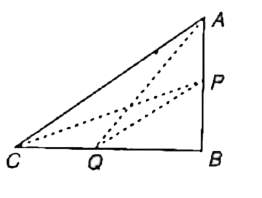BD is the disector of angle ABC. From a point P in BD, perpendiculars PE and PF are drawn to AB and BC respectively, prove that :
(i) Triangle BEP is conguent to triangle BFP (ii) PE=PF.
The correct Answer is:(i) x=45,y=87 (ii) x=75,y=16
To solve the problem step by step, let's break it down into two parts as required by the question.
Given:
- BD is the bisector of angle ABC.
- P is a point on BD.
- PE and PF are perpendiculars drawn from P to AB and BC respectively.
To Prove:
1. Triangle BEP is congruent to triangle BFP.
2. PE = PF.
1. Identify the Angles:
- Since BD is the bisector of angle ABC, we have:
∠ABP=∠CBP(let's call this angle 1 and angle 2)
2. Identify Right Angles:
- Since PE is perpendicular to AB, we have:
∠PEB=90∘
- Since PF is perpendicular to BC, we have:
∠PFB=90∘
3. Common Side:
- The side BP is common to both triangles BEP and BFP:
BP=BP
4. Apply the Angle-Side-Angle (ASA) Congruence Criterion:
- We have:
- ∠ABP=∠CBP (Angle 1 = Angle 2)
- ∠PEB=∠PFB=90∘
- BP=BP (Common side)
- Therefore, by the ASA criterion:
△BEP≅△BFP
Part (ii): Proving PE = PF
5. Using Corresponding Parts of Congruent Triangles:
- Since we have established that △BEP≅△BFP, by the property of congruent triangles, we can say:
PE=PF(CPCT)
Conclusion:
1. We have proved that triangle BEP is congruent to triangle BFP.
2. We have also proved that PE = PF.
- BD is the bisector of angle ABC.
- P is a point on BD.
- PE and PF are perpendiculars drawn from P to AB and BC respectively.
1. Triangle BEP is congruent to triangle BFP.
2. PE = PF.
- Since BD is the bisector of angle ABC, we have:
∠ABP=∠CBP(let's call this angle 1 and angle 2)
- Since PE is perpendicular to AB, we have:
∠PEB=90∘
- Since PF is perpendicular to BC, we have:
∠PFB=90∘
- The side BP is common to both triangles BEP and BFP:
BP=BP
- We have:
- ∠ABP=∠CBP (Angle 1 = Angle 2)
- ∠PEB=∠PFB=90∘
- BP=BP (Common side)
- Therefore, by the ASA criterion:
△BEP≅△BFP
- Since we have established that △BEP≅△BFP, by the property of congruent triangles, we can say:
PE=PF(CPCT)
1. We have proved that triangle BEP is congruent to triangle BFP.
2. We have also proved that PE = PF.
Topper's Solved these Questions
- BOOK - NAGEEN PRAKASHANCHAPTER - TRIANGLESEXERCISE - Exercise 7b15videos
TRIANGLES
- BOOK - NAGEEN PRAKASHANCHAPTER - TRIANGLESEXERCISE - Revision Exercise (very Short Answer Questions)10videos
TRIANGLES
- BOOK - NAGEEN PRAKASHANCHAPTER - TRIANGLESEXERCISE - Problems From NCERT/exemplar5videos
TRIANGLES
- BOOK - NAGEEN PRAKASHANCHAPTER - SURFACE AREA AND VOLUMEEXERCISE - Revision Exercise (long Answer Questions)10videos
SURFACE AREA AND VOLUME
Similar Questions
Knowledge Check
- Question 1 - Select One
From a point O in the interior of a DeltaABC perpendiculars OD, OE and OF are drawn to the sides BC, CA and AB respectively, then which one of the following is true ?
AAF2+BD2+CE2=AE2+CD2+BF2BAB2+BC2=AC2CAF2+BD2+CE2=OA2+OB2+OC2DAF2+BD2+CE2=OD2+OE2+OF2 - Question 2 - Select One
In ΔABC,BDandCEareperpendica––r→ACandABrespectively.IfBD = CE,thenDelta ABC is
AEquilateralBIsoscelesCRight-angledDScalene - Question 3 - Select One
In right angled ΔABC,∠B=90∘, if P and Q are points on the sides AB and BC respectively, then :
 AAQ2+CP2=2(AC2+PQ2)BAQ2+CP2=AC2+PQ2C(AQ2+CP2)=12(AC2+PQ2)D(AQ+CP)=12(AC+PQ)
AAQ2+CP2=2(AC2+PQ2)BAQ2+CP2=AC2+PQ2C(AQ2+CP2)=12(AC2+PQ2)D(AQ+CP)=12(AC+PQ)
From a point O inside a triangle ABC, perpendiculars OD, OE and OF are drawn to the sides BC, CA and AB, respectively. Prove that the perpendiculars from A, B and C to the sides EF, FD and DE are concurrent
View SolutionABC is an equilateral triangle, and AD and BE are perpendiculars to BC and AC respectively. Prove that: 1. AD=BE 2. BD=CE [ΔABD=ΔBCE.]
View SolutionLet ABC be an equilateral triangle and P be a point within the triangle. Perpendicular PD, PE and PF are drawn to three sides of the triangle, then the value of AB+BC+CAPD+PE+PF is
View SolutionABC is right triangle right angled at B.If BD is the length of the perpendicular drawn from B to AC then
View SolutionAn isosceles triangle ABC is right angled at B.D is a point inside the triangle ABC. P and Q are the feet of the perpendiculars drawn from D on the sides AB and AC respectively of ΔABC. If AP = a cm, AQ = b cm and ∠BAD=15∘,sin75∘=
View Solution

